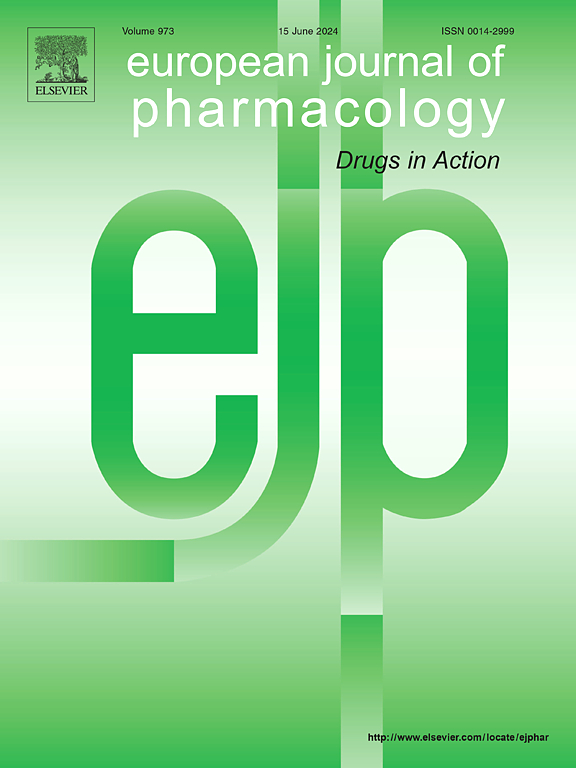通过调节 HSPA5/ GPX4 治疗阿尔茨海默病的卡他洛尔蛋白组变化
IF 4.7
3区 医学
Q1 PHARMACOLOGY & PHARMACY
引用次数: 0
摘要
阿尔茨海默病(AD)是一种慢性进行性神经退行性疾病,以细胞外淀粉样斑块和细胞内神经纤维缠结沉积为特征。传统的抗淀粉样变性药物具有很高的毒性,对患者的生活质量产生不利影响。因此,AD 急需新型治疗方法。近年来,通过调节脂质氧化作用来靶向铁氧化作用已成为治疗神经退行性疾病的一种新方法。梓醇(Catalpol)是从地黄根中分离出来的一种鸢尾甙,具有抗炎、抗氧化和神经保护的作用。因此,在本研究中,我们研究了梓醇在 APP/PS1 AD 小鼠模型中的保护作用及其相关内在机制。梓醇治疗明显改善了小鼠的认知能力,降低了Aβ1-40和Aβ1-42的水平。形态学测试表明,梓醇能防止海马CA1区神经元丢失并减少线粒体肿胀。蛋白质组学研究发现,有2495个海马蛋白的表达与梓醇治疗机制有关,其中包括44个与铁突变相关的蛋白。生物信息学分析表明,梓醇能显著提高海马中HSPA5和GPX4的蛋白水平。此外,catalpol 还调节了与细胞凋亡、细胞因子介导的信号传导和铁变态反应相关的生物通路。梓醇对HSPA5和GPX4的显著上调作用通过Western印迹得到了进一步证实。梓醇通过多种机制表现出神经保护作用。其中,与铁突变相关的HSPA5和GPX4可能在AD发病机制中发挥关键作用,是很有前景的治疗靶点。本文章由计算机程序翻译,如有差异,请以英文原文为准。
Proteomic alteration in catalpol treatment of Alzheimer's disease by regulating HSPA5/ GPX4
Alzheimer's disease (AD), a chronic and progressive neurodegenerative disease, is characterized by the deposition of extracellular amyloid plaques and intracellular neurofibrillary tangles. Conventional anti-AD drugs exhibit high toxicity and adversely impact patients' quality of life. Therefore, novel treatments for AD are urgently required. In recent years, targeting ferroptosis through the modulation of lipid oxidation has emerged as a new approach in the treatment of neurodegenerative diseases. Catalpol, an iridoid glycoside isolated from the roots of Rehmannia glutinosa, has exhibited anti-inflammatory, antioxidant, and neuroprotective properties. Therefore, in this study, we investigated the protective effects and associated underlying mechanisms of catalpol in an APP/PS1 AD mouse model. Catalpol treatment significantly improved the cognitive capabilities and decreased Aβ1-40 and Aβ1-42 levels in mice. Morphological testing revealed that catalpol prevented neuronal loss and reduced mitochondrial swelling in the hippocampal CA1 region. Proteomic studies identified 2495 hippocampus proteins whose expression was associated with the mechanism of catalpol treatment, including 44 ferroptosis-related proteins. Bioinformatic analysis revealed that catalpol significantly increased the protein levels of HSPA5 and GPX4 in the hippocampus. Additionally, catalpol modulated biological pathways related to apoptosis, cytokine-mediated signaling, and ferroptosis. The considerable upregulation of HSPA5 and GPX4 with catalpol was further confirmed through western blotting. Catalpol exhibited neuroprotective effects through a variety of mechanisms. Among these, HSPA5 and GPX4, associated with ferroptosis, may play key roles in AD pathogenesis, and present promising therapeutic targets.
求助全文
通过发布文献求助,成功后即可免费获取论文全文。
去求助
来源期刊
CiteScore
9.00
自引率
0.00%
发文量
572
审稿时长
34 days
期刊介绍:
The European Journal of Pharmacology publishes research papers covering all aspects of experimental pharmacology with focus on the mechanism of action of structurally identified compounds affecting biological systems.
The scope includes:
Behavioural pharmacology
Neuropharmacology and analgesia
Cardiovascular pharmacology
Pulmonary, gastrointestinal and urogenital pharmacology
Endocrine pharmacology
Immunopharmacology and inflammation
Molecular and cellular pharmacology
Regenerative pharmacology
Biologicals and biotherapeutics
Translational pharmacology
Nutriceutical pharmacology.

 求助内容:
求助内容: 应助结果提醒方式:
应助结果提醒方式:


